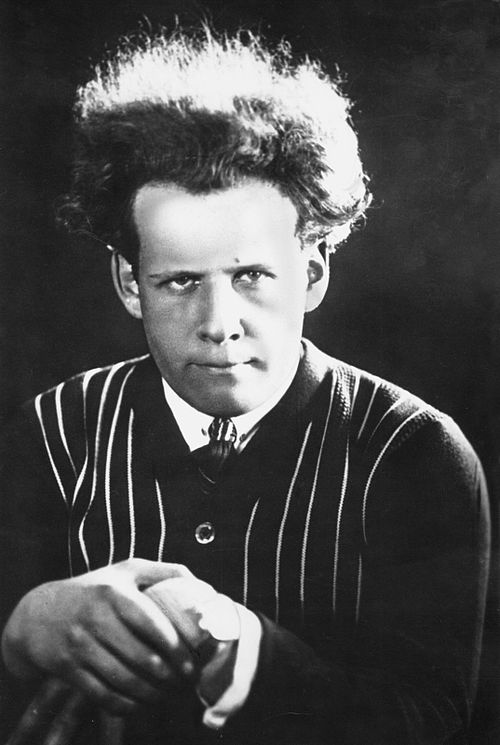Facts for Kids
Sergei Eisenstein was a revolutionary Soviet filmmaker whose work in montage and narrative has greatly influenced the art of cinema.
Overview
Later Life And Death
Legacy And Recognition
Theatre And Film Career
Early Life And Education
Analysis Of His Film Style
Major Works And Contributions
Innovations In Film Techniques
Political And Cultural Influence

Inside this Article
Russian Revolution
Alfred Hitchcock
Entertainment
Government
Literature
Creativity
Concept
October
People
Did you know?
🎬 Sergei Eisenstein was a pioneering Soviet film director and film theorist.
📽️ He is best known for his films such as Battleship Potemkin and October.
🎥 Eisenstein's techniques influenced the development of montage in cinema.
📚 He wrote extensively on film theory and the art of cinema.
🛳️ Battleship Potemkin’s famous Odessa Steps sequence is a landmark in film history.
🎉 Eisenstein was awarded the Stalin Prize for his contributions to cinema.
🌍 He also directed films in Mexico and was influenced by indigenous art.
📖 Eisenstein's approach combined his interest in Marxism with artistic expression.
✈️ He faced censorship and political pressure throughout his career.
🏆 Eisenstein is considered one of the greatest filmmakers of the silent and early sound eras.
Introduction
He is known as one of the most important people in the history of cinema. He loved to make movies that told powerful stories about people and their lives. Eisenstein helped change how films are made, using exciting techniques that made people think and feel deeply. His movies usually covered themes of revolution and heroism and were great for educating people about history and society. You might not have seen his films yet, but his influence is still felt in movies today! 🌟
Later Life And Death
He worked on films like "Ivan the Terrible" (1944), which celebrated the powerful Russian leader. However, he faced pressure from the Soviet government about his artistic choices. Eisenstein's health started to decline in the 1940s, and he sadly passed away on February 11, 1948, in Moscow, Russia. 🕊
️ Despite his death, his legacy lives on! Today, we remember Eisenstein as a brilliant filmmaker who changed the way we see and create films. He taught us that movies can inspire change and tell important stories. 🎬
Legacy And Recognition
He won several awards for his incredible work, and movies based on his techniques are still being made today. People around the world study Eisenstein's films to learn about filmmaking. His techniques are taught in film schools, and many famous directors, like Alfred Hitchcock and Martin Scorsese, have been inspired by him. 🎓
The "Eisenstein Institute" was even founded to honor his legacy! Every time you watch a movie with exciting editing or storytelling, you can thank Eisenstein for helping to create those amazing experiences! 🎉
Theatre And Film Career
In 1925, he released his first film, "Strike," about a worker's rebellion. It was groundbreaking! 🚩
He created dramatic scenes using editing techniques that no one had seen before. Eisenstein is also famous for his film "Battleship Potemkin" (1925), which shows a real-life event from the Russian Revolution. The film's amazing scenes, especially the "Odessa Steps," became famous worldwide. Eisenstein's unique style made him a superstar in the film industry! 🌏
Early Life And Education
He studied at the Polytechnic Institute in the early 1920s and loved art, theatre, and literature. Eisenstein was also a talented artist! 🎨
He was inspired by the Russian Revolution of 1917, which greatly influenced his work later. In 1920, he joined the Red Army as a director of theatrical productions. This experience helped him understand how to tell stories through visuals—perfect for making films! 🚀
With a background in art and a passion for storytelling, he was ready to take on cinema!
Analysis Of His Film Style
He masterfully used montage to create exciting scenes that made people feel as if they were part of the action! By using quick cuts between different images, he told stories on multiple levels. He also played with light, shadow, and camera angles, making every shot speak volumes! 🎥
His movies often featured dramatic themes, including social change and human struggle, which keep audiences engaged. This unique way of storytelling was so powerful that it influenced the style of future filmmakers and still impacts how films are made today! 📽
️
Major Works And Contributions
Besides "Battleship Potemkin," he made "October" (1928), which celebrated the 1917 Revolution, and "The General Line" (1929). His movies made people think deeply about society and politics. 🕊
️ He brought the ideas of revolutionary change into people's homes. He used amazing visuals and powerful stories to educate audiences. Eisenstein also developed the "Geometric Principles of Editing," which taught filmmakers about rhythm and structure in their movies. Because of his creativity, he became a pioneer of Soviet cinema! 🌟
Innovations In Film Techniques
️ One of his biggest contributions was the concept of "montage," which means editing different shots together to create emotions and meaning. For example, by quickly showing images of people and events, he could convey powerful messages! 💥
Eisenstein believed that combining different scenes made the audience feel stronger feelings, like joy, anger, or sadness. He also used music to help tell the story. His innovative ideas have influenced many filmmakers today, and the word "montage" is still used in films everywhere! 🎶
Political And Cultural Influence
His works often inspired people to think about freedom and justice. For example, "Battleship Potemkin" encouraged viewers to stand up against oppression. ⚔
️ In the Soviet Union, Eisenstein's films supported the Communist Party, promoting their ideas through art. However, his work has also been celebrated globally, inspiring filmmakers from many different backgrounds! Eisenstein showed that movies can be more than just entertainment—they can tell important stories that spark change and make a difference in society! 🌍

